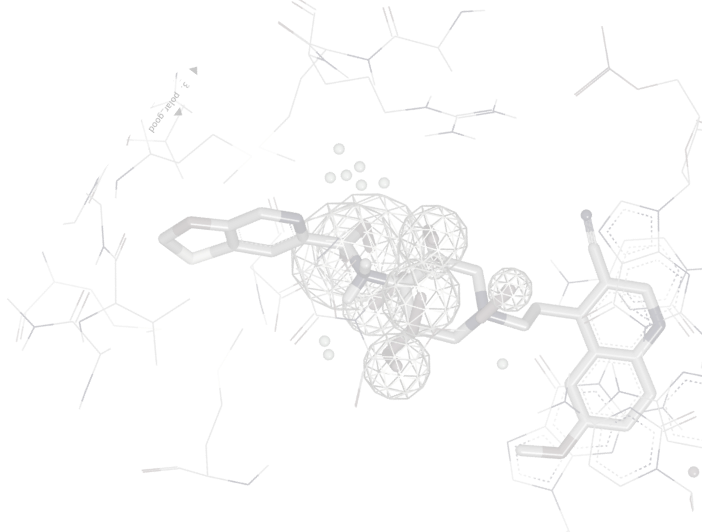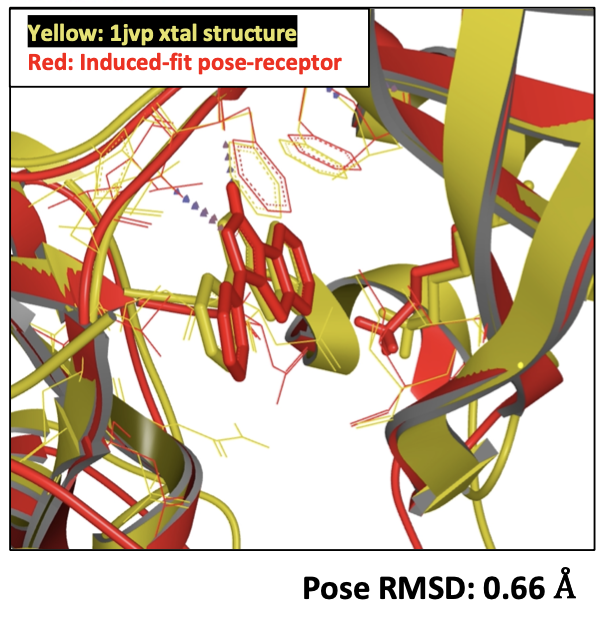
Induced-Fit Posing
Improve your hit-to-lead pose prediction accuracy with OpenEye's Induced-Fit Posing (IFP).
Predicting the binding of diverse ligands is particularly challenging when adjustments are required in the receptor’s binding site. Adjustments in the binding site can significantly alter binding affinity, making accurate predictions difficult. Induced-Fit Posing, also known as induced-fit docking, provides a specialized approach for accurately predicting binding poses in such situations.
Developed in collaboration with an industry partner, OpenEye's IFP enables scientists to accurately predict the binding configurations of ligands that impact the side chains of receptor binding site residues. Our results demonstrate that IFP significantly outperforms standard docking, achieving over a 20% improvement in successful prediction rates.
Use OpenEye's IFP to gain insights into the binding mode of your compounds with flexible target sites and streamline the selection of your lead compounds for optimization.

Features
- Easy-to-Use. Quickly get up and running in a familiar Orion web-based environment
- Automated. A unified workflow that generates diverse docking options, characterizes binding pocket accommodation, and scoring alternatives
- Performance. Sampling of active site to yield accurate results
- Versatile. Explore diverse ligand chemotypes in a flexible protein environment
- Control. Highly customizable for novice use and expert control
- Integrated. Easily combine with other ligand- and structure-based methods
Improve your pose prediction accuracy
Developed with an industry partner, OpenEye's IFP uses short-trajectory molecular dynamics simulations post-docking to better model protein flexibility during induced-fit.
Accurate prediction of binding modes is essential in structure-based drug design. While high accuracy is relatively easy to achieve in lead optimization, where molecules are similar to known crystallographic ligands, hit-to-lead often involves examining diverse chemotypes dissimilar to known binding modes, which can reduce pose prediction reliability. OpenEye's IFP tackles this challenge by optimizing leads from diverse compounds. It enhances permissive docking through short molecular dynamics simulations to capture induced protein reorganization.
Download the OpenEye Science Brief on Accurate Binding Pose Prediction with Induced-Fit posing (IFP)


Why use OpenEye's Induced-Fit Posing?
In a retrospective cross-docking studies across diverse protein targets, OpenEye's IFP yielded over 20% improved accuracy compared to standard docking approaches.
The automated 3-step IFP protocol provides an off-the-shelf solution for scientists. In the initial step, binding site residues are pruned to create more space for docked molecules. Binding hypotheses are then generated in both pruned and unpruned receptors using standard docking protocols to maximize pose reliability. High-scoring poses from docking undergo a short trajectory MD simulation (STMD), which allows for side chain adjustments and ligand repositioning. Clustering trajectories from STMD yields representative, low-energy poses with associated binding site conformations. These conformations are then scored using a consensus method that integrates MM-PBSA, docking scores, and knowledge-based protein-ligand interaction assessments.

FAQs
-
Yes. To enhance your ability to predict ligand binding affinity for proteins with flexible target sites, consider leveraging both IFP and OE Affinity. The combination of these tools is expected to increase the accuracy of ligand-protein binding predictions.
-
Yes. OpenEye's IFP is suited for novice and advanced users. From receptor pruning, to docking, to MD, users have the ability to fine tune IFP parameters.
-
Users get a comprehensive and interactive report of protein-ligand interactions, cluster analysis, and protein RMSD for the top ranked poses.
Additionally, IFP offers users scores derived from a consensus method that integrates MM-PBSA, docking scores, and knowledge-based assessments of protein-ligand interactions.
-
OpenEye's Induced-Fit Posing provides users with fast and state-of-the-art calculations, comparable in cost with other commercially available methods. In addition, users are not limited by token and can run unlimited numbers of simultaneous IFP calculations.
Learn More
Download OpenEye Science Brief on Accurate Binding Pose Prediction with Induced-fit posing (IFP)
For science details, WATCH OpenEye’s 2024 miniWebinar recording by Hyesu Jang, PhD, on Induced Fit Posing
References
-
Induced-Fit Posing (IFP): A new pose prediction tool for hit to lead stage of drug discovery, ACS National Meeting, August 2023
miniWebinar: Opening up the druggable universe one cryptic pocket at a time
miniCUP Cambridge 2025
Expanding Orion’s Capabilities with AI
miniWebinar: Faster, Larger, Smarter: Filling the Funnel for Ultra-Large Scale Virtual Screening
Resources
Glimpse the Future through News, Events, Webinars and more
Event
miniCUP Basel 2025
Webinar
miniWebinar: Opening up the druggable universe one cryptic pocket at a time


